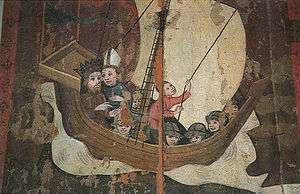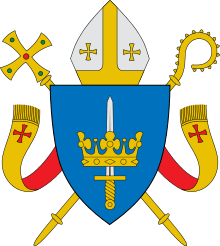First Swedish Crusade
The First Swedish Crusade was a mythical military expedition in the 1150s to Southwest Finland by Swedish King Eric IX and English Bishop Henry of Uppsala.

| Christianization of Finland | ||||||||
|---|---|---|---|---|---|---|---|---|
 | ||||||||
| People | ||||||||
|
||||||||
| Locations | ||||||||
| Kokemäki ● Köyliö ● Nousiainen ● Koroinen ● Turku Cathedral | ||||||||
| Events | ||||||||
| Finnish-Novgorodian wars First Swedish Crusade Second Swedish Crusade Third Swedish Crusade | ||||||||
Earliest written sources of the crusade are from the end of 13th Century. The main sources of the crusade, the legend of Saint Erik and the legend of Saint Henry, describes that the reason for the crusade were the multiple raids that pagan Finns made to Sweden.[1]
The crusade has traditionally been seen as the first attempt of the Catholic Church and Sweden to convert pagan Finns to Christianity. However, the Christianisation of the South-western part of Finland is known to have already started in 10th century, and in the 12th century, the area was probably almost entirely Christian.[2] According to legends, after the crusade Bishop Henry was killed at lake Köyliönjärvi by Lalli. He later became a central figure of the Catholic Church in Finland.[3]
Veracity of the crusade
Academics debate whether this crusade actually took place. No archaeological data give any support for it and earliest written sources are from much later date. No surviving written source describes Swedish influence in Finland before the end of the 13th Century. Furthermore, the diocese and bishop of Finland are not listed among their Swedish counterparts before the 1250s. Also, the Christianisation of the South-western part of Finland is known to have already started in 10th century, and in the 12th century, the area was probably almost entirely Christian.[2]
The Swedish bishop normally involved in the eastern campaigns was the Bishop of Linköping, not the Bishop of Uppsala.
The mid-12th century was a very violent time in the northern Baltic sea, with Finnish tribes such as Tavastians and Karelians as well as Swedes in frequent conflicts with Novgorod and with each other.[4] The First Novgorod Chronicle tells that in 1142 a Swedish "prince" and bishop accompanied by a fleet of 60 ships plundered just three Novgorodian merchant vessels somewhere "on the other side of the sea", obviously being after something more important.[5]
Timing of the crusade
Almost every year of the 1150s has been suggested as the year that the crusade possibly took place. Most widely supported years have been years 1150, 1155, 1157 and 1158. Other candidates have been years 1153, 1154 and 1156.[6]
At the time, leading the leiðangr was the responsibility of the jarl. That gave rise to a theory that Eric conducted the expedition before he became king or pretender to the throne. Legends give no year for the expedition but attempts to date it to an exact year in the 1150s are all much later speculations. All that is known about King Eric and Bishop Henry is that they most probably held important positions in Sweden some time in the mid-12th century.
See also
- Second Swedish Crusade
- Third Swedish Crusade
- Northern Crusades
- Bishop Fulco
References
- Heikkilä, Tuomas (2006). Pyhän Henrikin Legenda. Helsinki: Suomalaisen kirjallisuuden seuran toimituksia 1039. pp. 138–139.
- Georg Haggren, Petri Halinen, Mika Lavento, Sami Raninen ja Anna Wessman (2015). Muinaisuutemme jäljet. Gaudeamus. p. 343.CS1 maint: multiple names: authors list (link)
- "Eric's crusade to Finland". Archived from the original on 2007-09-27.. Original medieval legend in Latin.
- See articles Swedish-Novgorodian Wars and Prehistoric Finnish wars.
- "First Novgorod Chronicle entry on the attack in 1142". Archived from the original on 2007-09-27.. In Swedish.
- Heikkilä, Tuomas (2006). Pyhän Henrikin legenda. Helsinki: Suomalaisen kirjallisuuden seuran toimituksia 1039 (2.painos). pp. 55–56.
